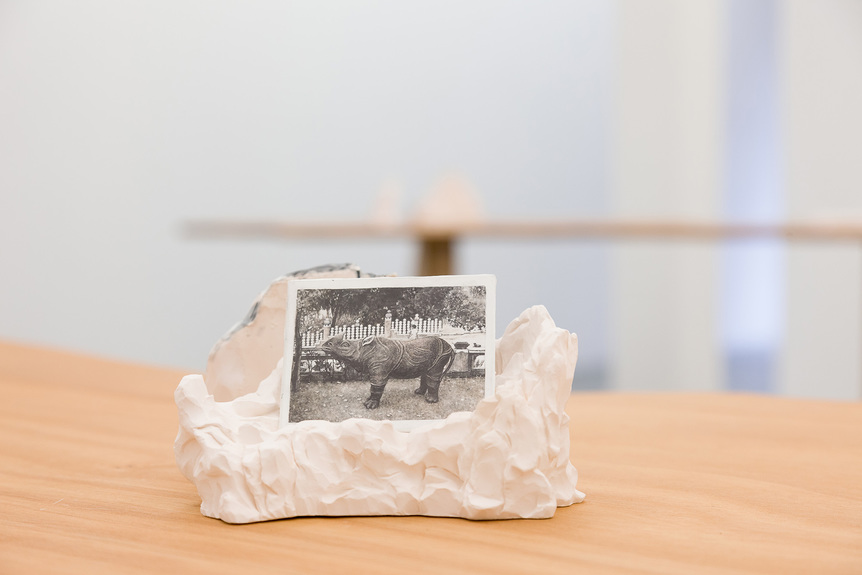-
From Current Issue
-
- Editor’s Letter Fire in the Heart
- Reviews I Gusti Ayu Kadek Murniasih
- Reviews 11th Seoul Mediacity Biennale: “One Escape at a Time”
- Dispatch Networked China
- One on One Monira Al Qadiri on Yukio Mishima
- Essays The rise of independent art spaces in pandemic-era Shanghai
- Features Tuan Andrew Nguyen
- Table of Contents
- Web Exclusives
- Archive
- Subscribe

R
E
V N
E
X
T
Installation view of JESS BRADFORD’s “An Image of a Tiger” at Galerie Pompom, Sydney, 2018. All photos by Docqment. All images courtesy the artist and Galerie Pompom.
When the Burmese-Chinese businessman and heir to the Tiger Balm dynasty Aw Boon Haw built a villa and cultural theme park in Singapore, he intended it to educate Singaporeans about traditional Chinese cultural values as an antidote to the island nation’s emerging cosmopolitanism. However, Haw Par Villa ultimately stands as a display of supposedly immutable values that has ended up a physically and culturally layered site due to numerous attempts at restoring and reinventing it, including through the incorporation of Western theme-park technology.
Singaporean-Australian artist Jess Bradford previously lived with her family near Haw Par Villa. Fascinated by its grottoes, which house garish representations of moral fables like the Ten Courts of Hell, and are decorated with repeated lumpy cement forms that variously represent caves, waves and clouds, the artist has made it the subject of her work for several years now. Using decades-old found black-and-white holiday snapshots of the park as a starting point, Bradford explores representational theory and the slippage between two- and three-dimensionality across painting, sculpture and installation in her latest show at Galerie Pompom, “An Image of a Tiger.”
As in previous exhibitions, the artist constructed a set piece to lure the audience into the works. In the past, Bradford has utilized a rocky proscenium arch and a mantelpiece with exposed back; this time, it was a large, wavy-edged, horseshoe-shaped table upon which her small-scale pastel-and-liquid-pencil renderings of anonymous archival photographs rested, each nestled in a bisque-fired porcelain “Rock Study” (all works 2018). Bradford is careful to remind us of the constructed nature of Haw Par Villa and her own representations of it, creating a train of references with opaque original authorship. Rendered on aluminum, with the roughly applied white primer glooping over the edges in places, the reproduced photographs include the original white borders, patches where the photographic layer has been scratched away to reveal the paper underneath, and sometimes small printed numbers in the lower right-hand corners, indicating the year the photo was taken. They depict decontextualized scenes from the park, such as a rhinoceros standing before an ornate fence, and a couple of visitors posing amongst statues of human-clothed monkeys.
Most of the rock sculptures are no larger than a brick and, softly daubed in pastel and ink shades, evoke the park’s grottoes in a style recalling traditional Chinese landscape paintings. The small porcelain sculptures are shaped on their faces but their versos are flat, revealing the artificiality of their construction. The artist likens this to the creation of three-dimensional shapes in computer graphics software, in which a seemingly three-dimensional object can be rotated in space to reveal a hollow or flat reverse side. Paradoxically, there is a flatness to Bradford’s sculptures and body to her paintings, with the cement forms described in the latter continuing beyond their white frame into the “Rock Study” holding it.
The table is the flattest of all the objects in the show, leveling all the cracks, crevices and details of the cement grottoes into its meandering edges and smooth surface. It’s an impressive piece of furniture-sculpture that succeeds in being inviting rather than imposing, due to the warmth of the plywood in its U-shape, which invites the viewer to examine the works up close. We could be standing in an unfamiliar home, checking out the photos and knickknacks and trying to piece together a narrative from the clues available, or surveying a single cartographic form, the angled legs (made from pieces offcut from the tabletop) giving the appearance of a sea bridge.
One can try to fix values in concrete but the world inevitably shifts around them. The narratives of Haw Par Villa’s grottoes may have been subsumed over time, just as the surrounding ocean has been pushed out by reclaimed land. With “An Image of a Tiger,” however, Bradford has used paint, porcelain and ply to mold a new monument to the layers of authorship, identity and history that have defined the villa and Singapore at large.
Jess Bradford’s “An Image of a Tiger” is on view at Galerie Pompom, Sydney, until November 11, 2018.
To read more of ArtAsiaPacific’s articles, visit our Digital Library.













